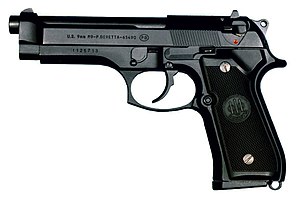Beretta M9
| Beretta M9 | |
|---|---|
 |
|
| Type | Semi-automatic pistol |
| Place of origin | Italy and the United States |
| Service history | |
| In service | 1990–present |
| Used by | United States Armed Forces |
| Wars | |
| Production history | |
| Designed | 1980s |
| Manufacturer | Beretta |
| Produced | 1990–present |
| Variants | M9A1 |
| Specifications | |
| Weight | Unloaded - 34.2 oz |
| Length | 217 mm (8.5 in) |
| Barrel length | 125 mm (4.9 in) |
|
|
|
| Cartridge | 9×19mm Parabellum |
| Action | Short recoil |
| Muzzle velocity | 381 m/s (1,250 ft/s) |
| Effective firing range | 50 m |
| Feed system | 15-round detachable box magazine |
| Sights | Iron sights |
The Beretta M9, officially the Pistol, Semiautomatic, 9mm, M9, is a 9×19mm Parabellum pistol adopted by the United States Armed Forces in 1985. It is essentially a military specification Beretta 92FS.
The M9 won a competition in the 1980s to replace the M1911A1 as the primary sidearm of the U.S. military, beating many other contenders, and only narrowly defeating the SIG P226 for cost reasons. It officially entered service in 1990. Some other models have been adopted to a lesser extent, namely the M11 pistol, and other models remain in use in certain niches.
The M9 was scheduled to be replaced under a United States Army program, the Future Handgun System (FHS), which was merged with the SOF Combat Pistol program to create the Joint Combat Pistol (JCP). The JCP was renamed Combat Pistol (CP), and the number of pistols to be bought was drastically cut back. The U.S. Army and Air Force are seeking to replace their M9s through the Modular Handgun System program.
In the 1970s every branch of the U.S. Armed Forces except the U.S. Air Force carried the .45 ACP M1911 pistol. USAF opted to use .38 special revolvers, which were also carried by some criminal investigation/military police organizations, USAF strategic missile (ICBM) officer crews, and by military flight crewmembers across all the services when serving in combat zones or when engaged in nuclear weapons duties.
The Department of Defense then decided to synchronize the weapons of all five branches of U.S. forces. The ground combat branches of the services found this decision highly contentious, but was meant to eliminate the need to buy replacements for worn out M1911 frames and to establish a common NATO pistol round to simplify logistics in case of war with the Soviet Union in Europe. In 1979 the Joint Service Small Arms Program began searching for a replacement for the venerable M1911, and the 9×19mm Parabellum round was selected for compliance with the NATO Standardization Agreement (STANAG). In 1980, the Beretta 92S-1 design was chosen over entries from Colt, Smith & Wesson, Walther, the Star M28, and various Fabrique Nationale and Heckler & Koch models.
...
Wikipedia
